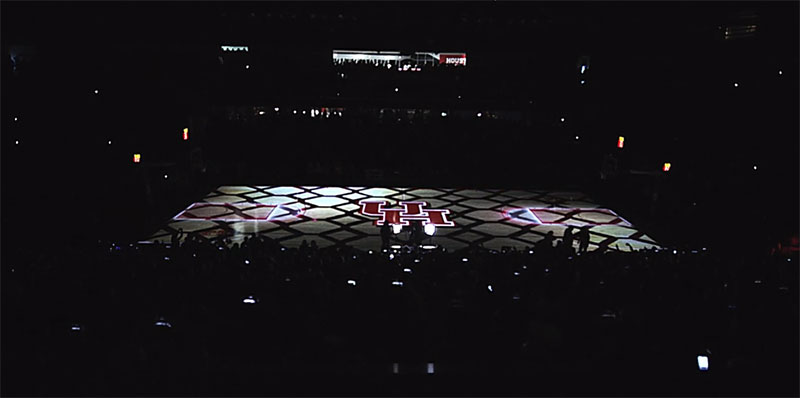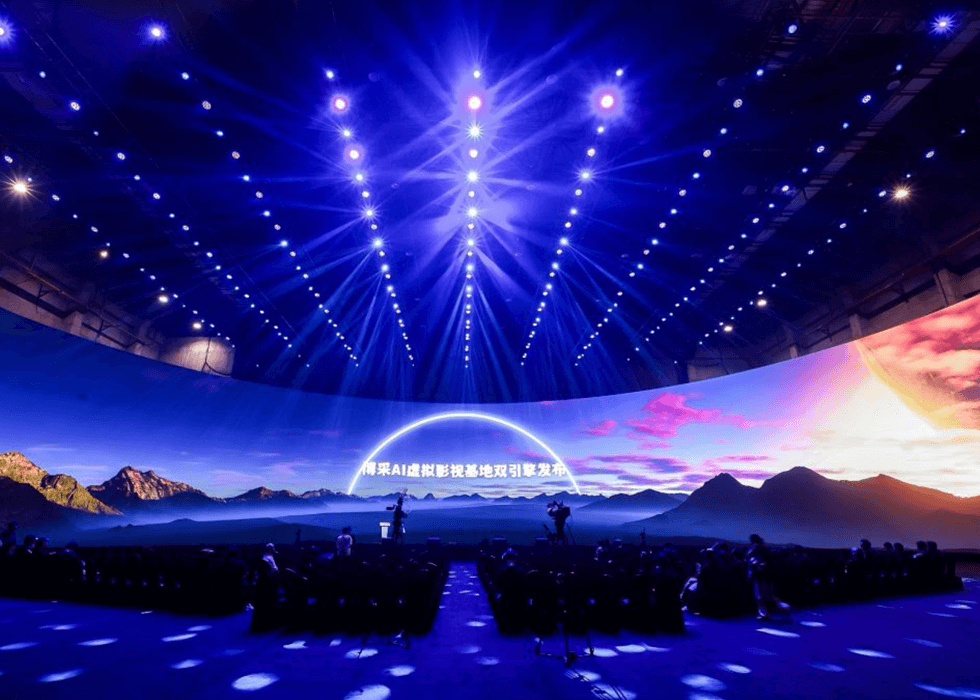More College Basketball Players Are Playing Video Games With the Ultimate Big-Screen TV on Court
There’s a new kind of FOMO happening in basketball. It turns out even the biggest big-screen TV can’t rival a full-court projection experience. The lights go down and the mega-brightness projectors fire up, transforming the gleaming hardwood into a rectangle of rich imagery and motion graphics.
Best seen (and heard) in person but equally friendly for broadcast, on-court projection is a compelling new reason for fans to leave their homes and see a game in person. Arenas with multisensory full-court shows are selling out on a regular basis, and now the effect is also being felt at the college level, as more NCAA teams upgrade to pro-level video spectacle.
One of the full-service integration firms delivering this team-spirit enhancement is Quince Imaging. Creating content and building the display systems to make it mega, Quince has been gaining notoriety for its board-boosting work for the Cleveland Cavaliers and many other teams.
The college venue expansion was not entirely unexpected for Quince, which happened to do the NCAA Final Four on-court projection for the past two years. In those same two years, the firm implemented dazzling on-court projection content and display systems for the University of Houston Cougars and the Villanova Wildcats.
 Finneran Pavilion, Villanova University
Finneran Pavilion, Villanova University
 Finneran Pavilion, Villanova University
Finneran Pavilion, Villanova University
Of course, the move to college arenas is not just a cut-and-paste scenario. College arenas are smaller than their NBA equivalents, with lower ceilings and fewer seats. While a ceiling-hung projection setup is comparatively straightforward in a larger arena, Quince Creative Director CJ Davis explains, “we've adjusted some of our approach to court projection for these college venues so that they meet all the same expectations that the pro teams would expect.” That may require the projection of video at carefully calibrated angles instead of straight down or utilizing projector arrays to make sure the whole rectangle glows with in-game excitement.
On the content side, there are also adjustments to be made. The college teams see what’s happening with the NBA and they want the same thing, Davis says. They want to see the court explode and fall apart, and they want their players 50 feet tall as the roster is called. “But in a smaller venue, it's a more intimate setting,” he points out. “More people are closer to the court, and a lot of these venues don't have a center-hung video display. So, the court becomes a main viewing surface.”
 Fertitta Center, University of Houston
Fertitta Center, University of Houston
That may change some of the look and feel of the content, but the diminutive scale of college arenas certainly can’t stop one NBA-level play. For its brand-new Fertitta Center, the University of Houston requested a real-time tracking system like the one Quince provided for the Cavaliers. That allows video graphics to be attached to a person or object and follow it on the court, which is particularly key to interactive elements like the “Pac-Man Maze” game that Quince created for the Cavs and then modified for use by the Cougars. “Now it’s the Cougar Chomp,” Davis elaborates. “They have fans run around on the court and they actually feel like they’re in a Pac-Man-esque environment, where they’re a cougar going after all the dots in the maze.”
Vigorous as always in their pursuit of visual perfection, the Quince team took it upon themselves to beta test the game quite a bit during the installation process. “It's just the most fun thing to program,” Davis says.
It’s not all fun and games though. These mega-scale productions go a long way in the intimidation department. “The in-game presentation teams are really getting aggressive in what they want to pull off against their rivals,” Davis notes.
And it’s not just on the home court, either. Quince has made a concerted effort to automate as much of the on-court shows as possible, so teams can take their graphics packages with them on the road. This was key for Villanova, which in addition to its home at the newly renovated Finneran Pavilion plays several games each season at the Wells Fargo Center, home of the Philadelphia 76ers.
On a pro level or college level, the goal is the same: convince fans to leave their big screen TVs at home and go to a live game. “Court projection is always a big part of that, whether it’s social media content, or pregame or halftime entertainment,” Davis observes. “It's hard to get people to go to a game, only to watch a game. This is the new norm, and it’s a necessity of an operating venue.”






